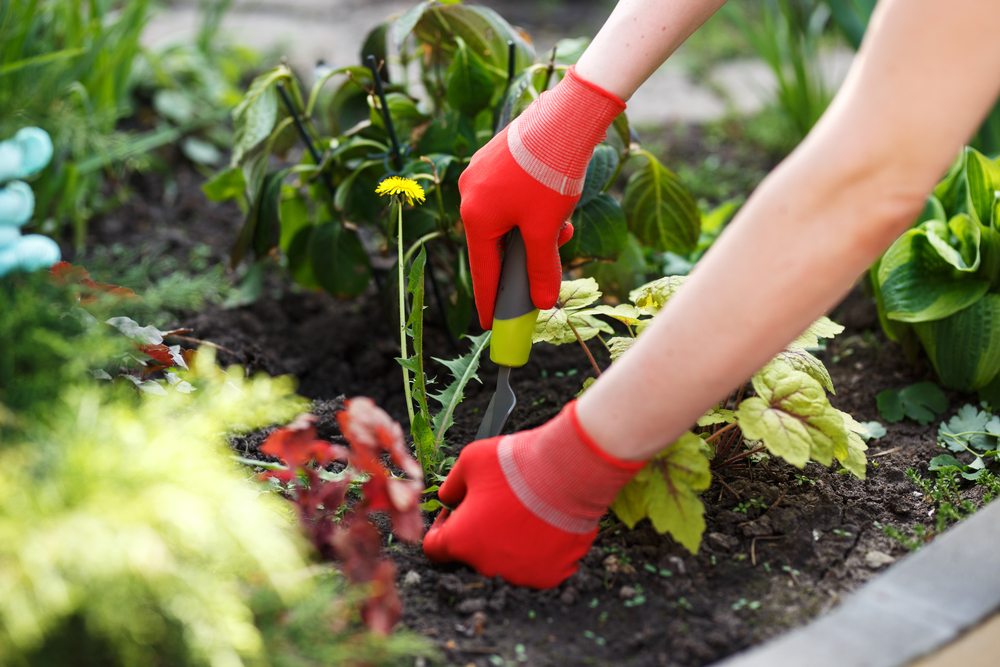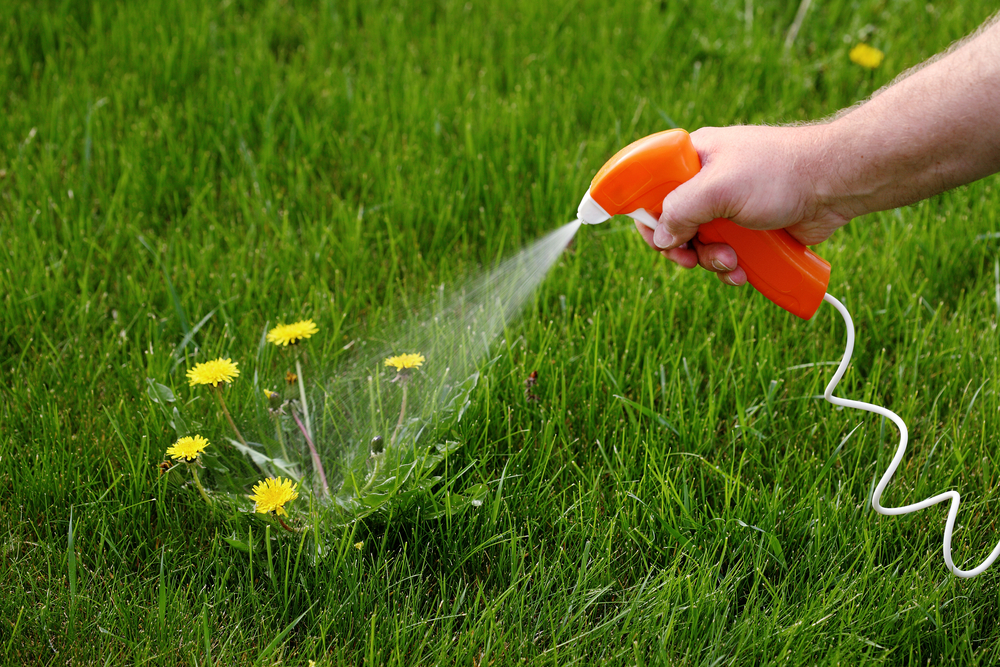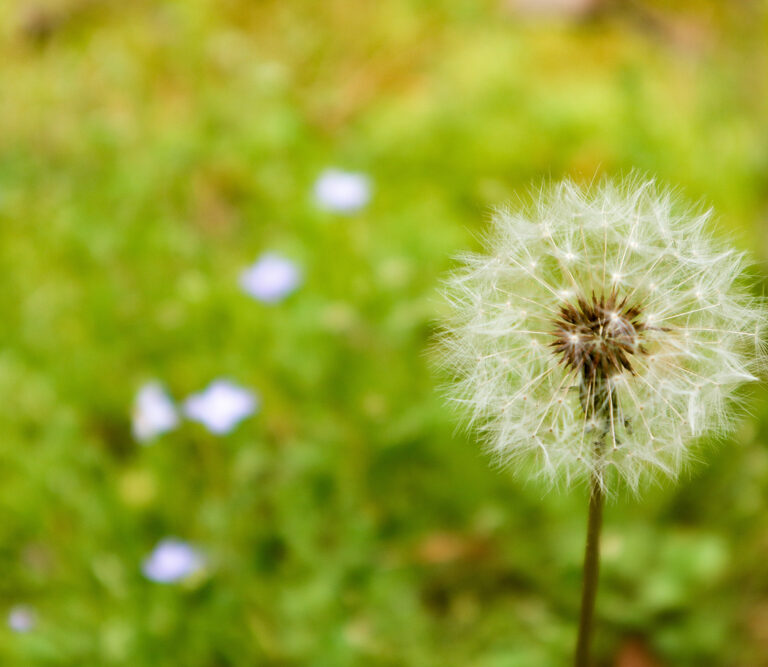Almost every year, most homeowners will notice a sea of dandelions sprouting from their ground. While these dainty, bright yellow flowers might look beautiful in the moment, they quickly develop fluffy seed heads that will be littered throughout your yard.
Once the dandelions have established a strong network of roots, removing them can feel almost impossible. This weed will return year after year. It’ll take a lot of hard work and persistence to finally turn your yard into a dandelion-free zone.
How to Remove Dandelions by Hand

If you’re removing dandelions by hand, it’s important to be persistent. The roots are deep underground and they break off easily, so it may take several seasons to get rid of them completely. To get rid of dandelions by hand, you’ll need a pair of gardening gloves, a weeding knife and a lot of time. Here are some tips that will make it easier to remove dandelions by hand:
- Water the soil. This will loosen the soil and make it a lot easier to get the entire dandelion out by the roots without leaving anything behind. When removing the dandelion, wiggle it slowly. You want to be gentle, so that you can pull out the entire root.
- Use a weeder tool. Attempting to pull out the dandelions by hand can be very taxing. You might not be able to get down to the roots, which is why many experts will recommend using a weeder tool.
- Pour some vinegar into the soil afterward. Make sure that you kill off any remaining roots that may be lingering in the soil by pouring some vinegar there. Be careful with where the vinegar touches because vinegar can kill off grass and other surrounding plants as well.
- Remove the dandelions before they sprout fluffy seeds. The moment that you see dandelions sprouting from your ground, take out your tools and get to work. By the time that the dandelions have sprouted fluffy seeds, they’re almost impossible to get rid of. With even the smallest movements, the seeds will go flying. They’ll take root wherever they land.
- Pull from the roots. Pull as deep down as possible. Don’t try to pull the dandelions by the stem because they’ll just break off from the roots. You’ll have a difficult time getting the rest of the roots out, and these roots will sprout new dandelions next year.
Removing dandelions by hand can take some time; however, by avoiding herbicides, you can rest assured that you’re not affecting any surrounding plants.
How to Remove Dandelions Using Herbicides

Removing dandelions by hand can be very time-consuming and physically taxing. The easiest way to get rid of dandelions is to use herbicides. When it comes to herbicides, you need to be very careful in choosing the right product. A lot of herbicides are nonselective, which essentially means that they’ll kill everything in their path. If you have some beautiful roses or bushes near the dandelions, they’ll be heavily affected by the herbicide too!
In addition to this, you also need to do some research. Some herbicides have even been in the news for causing major health problems. You want to take proper precautions if you decide to use these herbicides. Also, make sure that you keep your pets and children away from the yard for the time being!
Some factors that you should consider when choosing a herbicide include:
- Whether it’s selective or nonselective. Ideally, you want to go with a broadleaf herbicide that’s selective and designed to mostly target dandelions. These herbicides will kill the whole dandelion including the root, and will leave your other plants alone.
- Ease of application. Some herbicides can be sprayed directly on the dandelions. Others are much more concentrated and may need to be diluted. Look for a product that’s easy to use.
- Organic versus non-organic. Organic weed killers tend to encourage weed suppression. They’ll promote better soil health. On the other hand, non-organic tend to remove weeds much more quickly; however, they may have a negative impact on soil health. As a result, many prefer to avoid the chemical route and take a more natural approach using white wine and apple cider vinegar.
Finding the right herbicide can be a lot of work in and out of itself. Do a lot of research ahead of time, so you know exactly what you can expect from different products.
Wear Protective Clothing
When applying any type of herbicide, make sure that you wear protective clothing to avoid inhaling or coming into contact with the weed killer. Depending on the chemical composition of the product, it may contain some ingredients that are toxic to humans.
The personal protective equipment (PPE) that you need include:
- Rubber gloves. Gloves made from cloth can soak up the herbicide.
- Spray suits. If you don’t have a spray suit, make sure that you at least cover your body from head to toe. Wear pants instead of shorts and shoes instead of sandals.
- Safety goggles. For best protection, look for goggles that have covered vents on the sides and top. You want to make sure that none of the herbicide will come in contact with your eyes.
- Respirators. A paint or pesticide respirator will do the trick. Make sure that the respirator fits properly.
Read the instructions that come with each weed killer to make sure that you are fully protected.
Best Time to Remove Dandelions
If you already have dandelions in your yard and are looking to remove them once and for all, timing is very important. Dandelions are perennials. They die in the winter although the roots still live underground.
In the fall, the roots absorb most of the nutrients from the leaves to prepare for the cold winter ahead. This is the best time to remove dandelions if you are using a chemical herbicide. The herbicide you spray on the dandelions will be absorbed through the leaves and into the roots; thus, getting rid of the dandelions once and for all.
If you are removing the dandelions by hand, consider removing them in the spring. This allows you to harvest and eat the dandelion greens, which are rich in vitamin A, vitamin C, vitamin K, iron, folate and more. You can add these dandelion leaves to salads or you can boil or stir-fry them. You can even dry the roots and make a tea out of them.
What to Do After Dandelions Are Removed
Once you’ve removed the dandelions, whether by hand or using chemicals, you’ll want to reseed the soil. If you removed the dandelions by hand, reseed the soil immediately. If you’ve removed the dandelions using chemicals, wait two to three days before reseeding the soil to ensure that the chemicals won’t affect the new seeds.
By reseeding the soil immediately, you prevent nearby roots from making their way to the new soil and expanding. You can also prevent any dandelion seeds that may be hiding in the ground from rooting and sprouting.
How to Prevent Dandelions From Growing
Even if you are able to successfully get rid of all of the dandelions in your yard, it doesn’t mean that you won’t get dandelions next year. If your neighbor has a lot of dandelions, the fluffy seeds can easily get blown into your yard. Once these seeds ground themselves, they’ll grow deep into the soil, and you’ll see dandelions in your yard again next year.
The best way to prevent dandelions from growing on your lawn is to keep it healthy. The thicker your lawn is, the more difficult it will be for dandelion seeds to take root and grow.
- Water the lawn deeply but infrequently. You want to grow a strong and deep root system that will prevent any dandelion seeds from taking root in your yard.
- Be mindful of how much grass you cut. The more grass is on your lawn, the less likely dandelion seeds will be able to take root. Due to this reason, you definitely don’t want to mow your lawn too often or get rid of too much grass. Cut no more than a third of the grass on your yard at any time. This helps keep the grass healthy.
- Plant other hardy weeds and plants. Grass is not the only plant that will prevent dandelion seeds from taking root. You can also plant clover and other dense plants that will cover the soil and prevent dandelion seeds from rooting.
- Fertilize regularly. You definitely want to fertilize your lawn regularly, so that existing grass and plants can grow properly.
- Choose your grass wisely. Different types of grass grow better in different seasons. Bermuda and zoysia grass grow well in warmer climates while fescues grow well in cooler climates.
By taking care of your lawn, you can prevent dandelions from rooting and taking over.
Enjoy a Dandelion-Free Yard
Although dandelions are beautiful, you definitely want to get rid of them as soon as possible. These pesky weeds can easily take root and develop strong root systems. By then, getting rid of the dandelions for good can be quite a difficult task.
With that said, persistence and patience go a long way. With a little work, you too can have a dandelion-free lawn.
